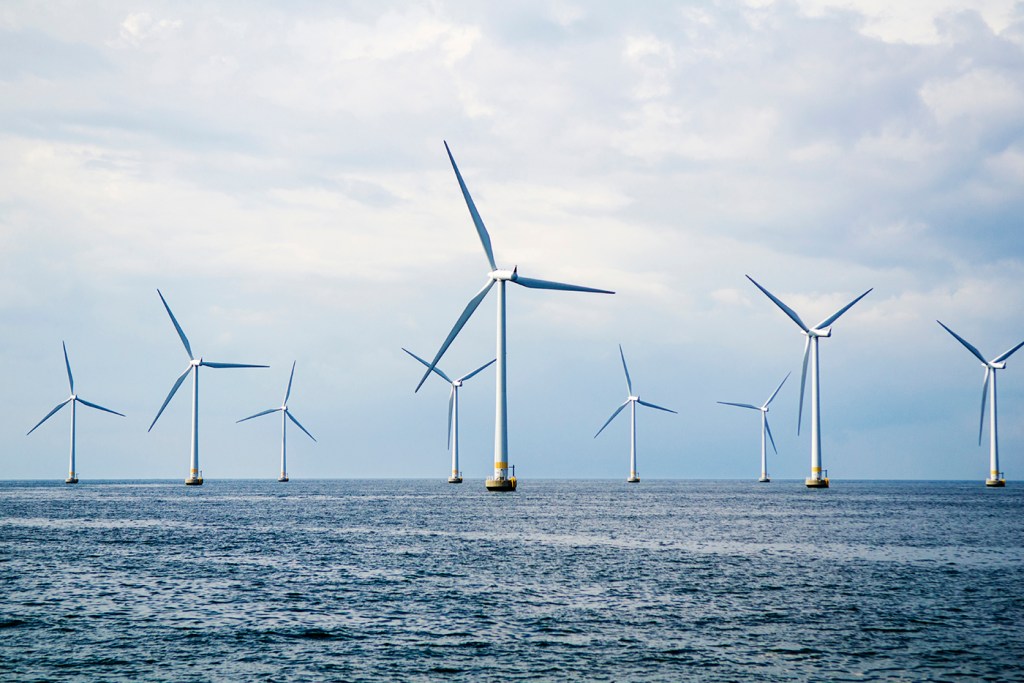3Qs: Offshore wind farms, hurricanes, and sustainability

Block Island, which is located 13 miles off the Rhode Island coast, will soon be home to North America’s first offshore wind farm. Late last month, Deepwater Wind, the company behind the $338 million project, installed the first of five steel foundations to the ocean floor—one for each wind turbine. The five turbines—which will be working by fall 2016—will be expected to produce enough energy to power 17,000 homes and cut the island’s energy bills by 40 percent.

Andrew Myers is an assistant professor of civil and environmental engineering who studies offshore wind structures and runs Northeastern’s Sustainable Structures Group. Here, he holds forth on the environmental effects of wind energy and his work to improve the design of hurricane-resistant offshore wind turbines.
America’s offshore wind industry is starting to grow. According to The Economist, the Bureau of Ocean Energy Management has issued nine commercial offshore wind leases to companies all along the eastern seaboard, the turbines for which could “generate enough energy to light up the equivalent of New Jersey.” In your view, how important is offshore wind energy to the long-term health and sustainability of the environment?
Accelerating the penetration of renewable energy into the national and global energy portfolio is among the most important technical and social challenges of our time. Transitioning from an energy economy based on traditional, carbon-based energy sources—coal, oil, and natural gas—to one based on renewable sources—in particular wind and solar—can cure many global problems, such as decreasing reserves of fossil fuels, air and water pollution, and climate change. I believe that this transition will require the advancement of technologies for harvesting many sources of renewable energy and that offshore wind energy in particular should play a prominent role.
Offshore wind energy is a vast, largely untapped resource of renewable energy with enormous potential. In the U.S., the potential resource is estimated to have a capacity close to the existing electricity capacity of the entire nation. The resource near Massachusetts is especially promising and accessible in shallow water. Offshore wind energy is a compelling source of renewable energy because offshore winds tend to be steadier and stronger than onshore winds and because many major population centers—Boston comes to mind—are located in close proximity to rich offshore wind resources. Relative proximity is important as it bypasses the burdens of long-distance energy transmission. Realizing these important benefits requires research aimed at reducing the cost of offshore wind energy, which is currently twice the cost of energy from traditional sources.
Some people object to offshore wind turbines, citing “noise, the blight on pristine views, and the above-market costs to consumers.” As an engineer and environmentalist, how would you respond to their concerns?
I think that it’s important to consider these objections in the design of offshore wind farms, and over time I anticipate improved engineering will help to mitigate them. It’s also relevant to consider these issues as compared to the alternatives for generating energy. For example, while the locations of some offshore wind turbines may alter coastal views, the construction of a new fossil fuel power plant is also disruptive to the natural aesthetic. I think wind turbines are beautiful and, in fact, while on vacation earlier this summer, I made a special trip to view the wind farm on Wolfe Island in Ontario. Regarding the above-market costs of offshore wind energy relative to traditional sources, I believe that many of the indirect costs of traditional sources of energy (e.g., pollution, climate change) are not fairly considered in such a comparison. The European Union has harvested offshore wind energy for more than two decades and has created long-lasting tax credits and other incentives that recognize these indirect costs and, as a result, now has more than 8 gigawatts of offshore wind energy capacity, 3 gigawatts under construction, and over 100 gigawatts proposed.
The Sustainable Structures group has received support from the National Science Foundation and the Massachusetts Clean Energy Center to conduct research into the hurricane resistant design of offshore wind turbine support structures. What particular contributions has your research group made?
We are thrilled to be at the forefront of such an important, emerging industry and to be supported by federal and state organizations. The Massachusetts Clean Energy Center has positioned the state to be a national leader in the offshore wind industry, and we are excited to work with them to design and construct a resilient and cooperative offshore wind energy network.
We have developed methods to better understand the damage that may occur to offshore wind farms exposed to the severe hurricanes that can occur off the Atlantic coast of the U.S. These hurricanes increase the risk that multiple offshore wind farms may be damaged or destroyed if they are not designed for the specific conditions along the Atlantic coast. As such, we are characterizing potential damage to offshore wind turbines from high winds and huge waves. We are also developing innovative approaches in which sacrificial structural ‘fuses,’ which may be readily replaced after a hurricane, are built into the turbine and are intentionally designed to fail so as to leave the remainder of the turbine undamaged. This is a similar concept to an electric fuse, which, in the event of an electric overload, is sacrificed to protect more important components downstream.





